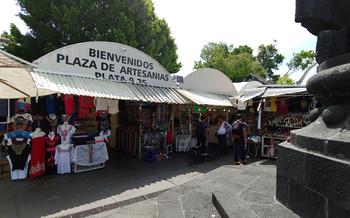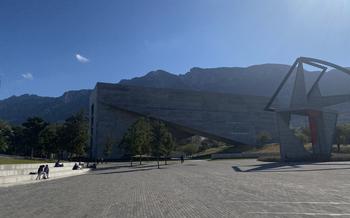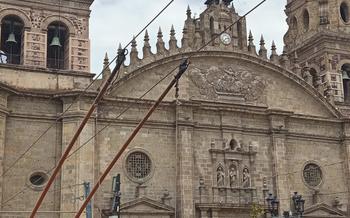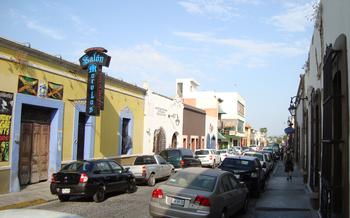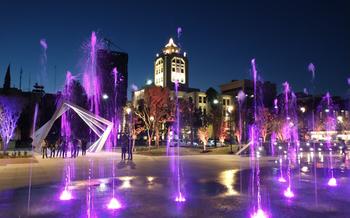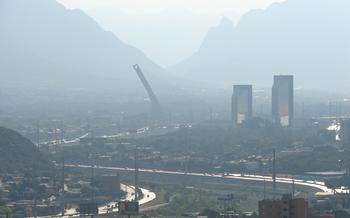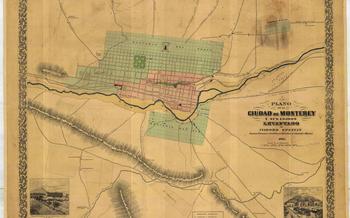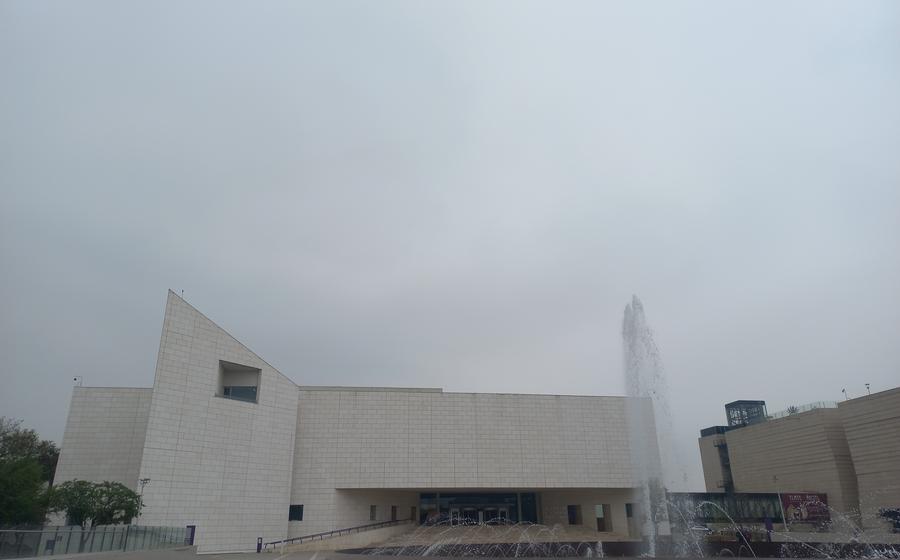
Museo de Historia Mexicana
- Museo de Historia Mexicana: Exploring Monterrey's Rich Past
- Historical Importance
- The Palace and Its Architecture
- The Collections
- Temporary Exhibitions
- Educational Programs
- Research and Publications
- Cultural Events: A Vibrant Hub of Art and Performance
- Guided Tours
- Accessibility
- Location and Transportation
- Amenities and Facilities
- Insider Tip:
Museo de Historia Mexicana: Exploring Monterrey's Rich Past
The Museo de Historia Mexicana in Monterrey, Mexico, is an institution dedicated to preserving and showcasing the rich history of the city and the surrounding region. Founded in 1990, the museum is housed in the historic Palacio del Obispado, a former bishop's palace that dates back to the 18th century. Its collection includes a diverse array of artifacts, documents, and artworks that narrate the story of Monterrey's transformation from a small colonial town to a thriving industrial metropolis.
Historical Overview Monterrey played a crucial role in Mexico's struggle for independence, serving as a strategic stronghold for both royalist and insurgent forces. The city's resilience and determination during this turbulent period are reflected in the museum's exhibits, which showcase artifacts such as weapons, uniforms, and personal belongings of key figures involved in the conflict.
Importance of the Museum The Museo de Historia Mexicana is recognized as one of the most important cultural institutions in Monterrey. It serves as a vital resource for researchers, students, and the general public, providing a comprehensive overview of the city's history and its contributions to Mexican culture.
Historical Importance
Monterrey's rich history is deeply entwined with the Museo de Historia Mexicana. The city, founded in 1596, played a pivotal role in key events that shaped Mexico's destiny. The museum stands as a testament to Monterrey's significance, showcasing artifacts and exhibits that illuminate the city's past.
The museum's collection offers a comprehensive narrative of Monterrey's journey, from its humble beginnings to its rise as a bustling industrial hub. Visitors can trace the city's transformation through interactive displays, historical documents, and captivating storytelling. The museum's exhibits highlight Monterrey's contributions to Mexico's independence movement, the Mexican-American War, and the country's economic development.
Beyond its role as a witness to history, the Museo de Historia Mexicana serves as a vital custodian of Monterrey's identity and heritage. The museum's mission is to preserve and promote the city's unique cultural legacy, ensuring that future generations can appreciate and learn from the past. Through its exhibitions, educational programs, and community outreach initiatives, the museum plays a crucial role in shaping the city's cultural landscape and fostering a sense of pride among its residents.
The Palace and Its Architecture
The Museo de Historia Mexicana is housed in the majestic Palacio del Obispado, a stunning example of colonial architecture that dates back to the 18th century. Originally constructed as the residence of the Bishop of Monterrey, the palace served as the seat of the Catholic Church in the region. Its grand facade, adorned with intricate stone carvings and a beautiful central courtyard, reflects the influence of both Spanish and Mexican architectural styles.
Over the years, the Palacio del Obispado has undergone several renovations and expansions, adapting to its changing roles and purposes. In the 19th century, it was transformed into a military barracks and later served as a government building. It was not until the 1990s that the palace was meticulously restored and repurposed as the Museo de Historia Mexicana.
The architectural features of the palace, from its arched doorways and vaulted ceilings to its elegant balconies and ornate ironwork, are a testament to the skill and craftsmanship of its builders. Each room and gallery within the museum retains its unique character, showcasing a harmonious blend of historical charm and modern functionality.
The Palacio del Obispado, with its rich history and architectural significance, serves as a fitting backdrop for the museum's collection of artifacts and exhibitions. Its grand spaces and evocative ambiance contribute to the immersive and educational experience that visitors enjoy at the Museo de Historia Mexicana.
The Collections
The Museo de Historia Mexicana boasts a diverse and rich collection of artifacts, documents, and artworks that narrate the captivating story of Monterrey and Mexico's past. From pre-Hispanic relics to colonial-era treasures and contemporary pieces, the museum's holdings offer a comprehensive insight into the region's cultural heritage.
Among the notable highlights of the collection are rare archaeological finds from ancient civilizations that once thrived in the area, such as the Olmecs and the Mayans. These artifacts provide a glimpse into the region's earliest inhabitants and their sophisticated cultures. The museum also houses an impressive collection of colonial-era documents, including maps, manuscripts, and letters that shed light on the city's founding and development during the Spanish colonial period.
Visitors can also admire a range of artworks that showcase the talent and creativity of Mexican artists throughout history. From traditional folk art to contemporary masterpieces, the museum's collection offers a diverse representation of Mexican artistic expression. One of the most striking pieces is a mural by renowned Mexican artist David Alfaro Siqueiros, which depicts the history of Monterrey and its role in the Mexican Revolution.
The curatorial approach at the Museo de Historia Mexicana is guided by a commitment to preserving and showcasing the region's unique cultural heritage. Through careful selection and arrangement, the museum's exhibits provide a cohesive narrative that allows visitors to understand the complex history and diverse cultural influences that have shaped Monterrey and Mexico.
Temporary Exhibitions
The Museo de Historia Mexicana presents a diverse range of temporary exhibitions that complement its permanent collection and explore various aspects of Mexican history and culture. These exhibitions change regularly, offering visitors new perspectives and insights. Some temporary exhibits focus on specific historical periods, such as the Mexican Revolution or the colonial era, while others delve into broader themes like art, music, or social movements. The museum also collaborates with other institutions and organizations to present special exhibitions, often featuring artifacts or artwork from around the world. Temporary exhibits add dynamism and variety to the museum's offerings, ensuring that there is always something new to discover.
Educational Programs
The Museo de Historia Mexicana is not just a repository of artifacts and documents; it is also a vibrant center for learning and education. The museum offers a wide range of educational programs designed to engage visitors of all ages and interests. Workshops, lectures, and other activities delve into various aspects of Mexican history, culture, and heritage. These programs are often tailored to specific age groups, ensuring that everyone can find something relevant and enjoyable.
The museum also actively engages with the local community through outreach initiatives and partnerships with schools and organizations. By bringing history to life through interactive and educational experiences, the Museo de Historia Mexicana plays a vital role in promoting lifelong learning and fostering a deeper appreciation for Mexico's rich cultural heritage.
Research and Publications
Beyond its role as a museum, the Museo de Historia Mexicana is also a hub for scholarly research and academic pursuits. The institution houses a specialized library and archive, containing a wealth of historical documents, manuscripts, and rare books. Researchers and historians from around the world come to consult these valuable resources, contributing to the advancement of knowledge in Mexican history.
The museum actively collaborates with universities, research institutions, and individual scholars to conduct research projects, organize conferences, and publish scholarly journals and monographs. These publications are widely recognized for their rigorous scholarship, contributing to the dissemination of historical knowledge and fostering a deeper understanding of Mexico's past.
The museum's commitment to research extends beyond its walls, as it actively engages in community outreach initiatives and educational programs. By working with local schools and universities, the museum promotes historical literacy and encourages young people to explore the rich history of their country. Through its research and publications, the Museo de Historia Mexicana plays a crucial role in preserving and disseminating historical knowledge, ensuring that the stories of Mexico's past continue to be told and remembered for generations to come.
Cultural Events: A Vibrant Hub of Art and Performance
The Museo de Historia Mexicana is not just a repository of historical artifacts; it is also a thriving cultural hub that hosts a diverse range of events that bring history to life. From concerts and theater performances to lectures and workshops, the museum offers a platform for local artists, performers, and scholars to showcase their talents and engage with the community.
Collaborating with local organizations and artists, the museum curates a dynamic program of cultural events that celebrate Monterrey's rich cultural heritage and promote contemporary artistic expression. During festivals and holidays, the museum transforms into a lively venue, hosting special events, exhibitions, and performances that immerse visitors in the city's vibrant cultural traditions.
Through these events, the Museo de Historia Mexicana fosters a sense of community and belonging, creating a space where people can come together to appreciate and celebrate the arts, while deepening their connection to the city's past and present.
Guided Tours
The Museo de Historia Mexicana offers guided tours to enhance visitors' experience and provide a deeper understanding of the exhibits. These tours are available in Spanish and English, catering to a diverse audience. The knowledgeable museum guides bring history to life, sharing fascinating stories and anecdotes about the artifacts and events displayed. Visitors can choose from general tours that provide an overview of the museum's collection to more specialized tours focused on specific themes or periods. Group tours can be customized to accommodate particular interests or educational needs. Whether you're a history buff or simply curious about Monterrey's past, the guided tours at the Museo de Historia Mexicana are an excellent way to immerse yourself in the rich cultural heritage of the city.
Accessibility
The Museo de Historia Mexicana is committed to ensuring that its exhibitions and programs are accessible to all visitors, regardless of their abilities. The museum offers a variety of accessibility features, including wheelchair accessibility, ramps, and elevators throughout the building. Audio guides are available in multiple languages, and sign language interpretation is provided for guided tours upon request. The museum staff is also trained to assist visitors with disabilities, and they are always happy to answer any questions or provide assistance. The museum's commitment to inclusivity and equal access makes it a welcoming and enjoyable experience for all visitors.
Location and Transportation
The Museo de Historia Mexicana enjoys a prime location in the heart of Monterrey, making it easily accessible to visitors. Situated on the historic Cerro del Obispado, the museum stands within the precincts of the Obispado Park, a popular recreational area offering stunning panoramic views of the city. The museum's proximity to other landmarks, such as the Catedral Metropolitana de Monterrey and the Palacio de Gobierno, allows visitors to combine their visit with a comprehensive exploration of Monterrey's rich heritage.
Reaching the museum is a breeze, with various transportation options available. The city's efficient public transportation system offers multiple bus routes that stop near the museum, ensuring easy access from different parts of the city. For those who prefer the convenience of driving, ample parking is available in the vicinity of the museum, eliminating the hassle of finding a spot. Whether you choose to walk, take public transportation, or drive, getting to the Museo de Historia Mexicana is a seamless experience, allowing you to focus on delving into the captivating world of Mexican history.
Amenities and Facilities
To enhance your museum experience, the Museo de Historia Mexicana offers a range of amenities and facilities. Browse the museum shop for unique souvenirs, publications, and historical artifacts to take home as mementos of your visit. When hunger calls, grab a bite to eat at the on-site café or restaurant, which offers a selection of refreshments and snacks to refuel your energy levels. The museum also provides restrooms and lockers for your convenience, ensuring a comfortable and enjoyable visit.
Insider Tip:
To avoid the crowds, plan your visit to the Museo de Historia Mexicana on a weekday morning or during the off-season. For a truly immersive experience, join one of the guided tours offered in Spanish or English. Keep an eye out for the hidden gem of the museum - the secret garden located behind the Palacio del Obispado. After your visit, indulge in some local flavors at one of the nearby restaurants in the Barrio Antiguo neighborhood. For a unique souvenir, stop by the museum shop and pick up a replica of an ancient artifact or a book on Mexican history.
